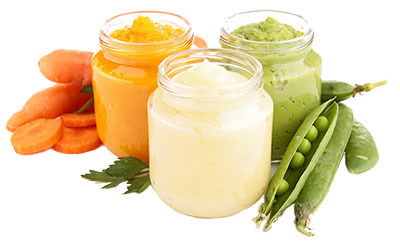Beginning Solid Food
 Generally speaking, avoid solid food for at least the first 6 months. Supplement milk only if absolutely necessary and choose fresh, unpasteurized goats milk or cow's milk from a reputable source.
Generally speaking, avoid solid food for at least the first 6 months. Supplement milk only if absolutely necessary and choose fresh, unpasteurized goats milk or cow's milk from a reputable source.
The most obvious sign to clue you in that your baby is ready for more solid food is teething. Teething is nature's way of preparing your baby for more solid food. Also, if your baby is sitting and crawling, these are also signs that it may be time to slowly introduce some solid food.
Sooner Is Not Better, Or Healthier
There is no rush for a baby to begin solid foods, and sooner is not better. Using nature and common sense as a guideline, our bodies are not intended to chew food until our teeth have developed. Breast milk is a nutritionally perfect food for much longer than 4-6 months – even up to one year of age or later for some babies. In fact, studies show that the longer babies continue on breast milk, the less they suffer from common childhood ailments.
If you are concerned that your baby may be underweight, this is not a sign to begin solid food. Breast milk is a richer and higher calorie food than most solid baby foods.
Age 6-12 Months
When it comes to beginning solid food, pureed and mushy fruits and vegetables with fresh fruit juices are the absolute best start in life. The thousands of vitamins, minerals, and antioxidants contained in fresh produce are invaluable to a growing child. It is very easy to puree your own variety of fruits and veggies - all you need is a blender or food processor and some jars!
| Great choices: | Avoid: | |
|
|
Preparing & Introducing Semi-Solid Food
- Lightly cook the veggies and puree them. Never cook fruits. It is completely unnecessary and serves only to destroy thousands of micro and macronutrients and antioxidants that are heat-sensitive. Many food enzymes do not survive high temperatures, and these enzymes help a baby's body predigest the food.
- Introduce one food at a time, and spread new foods several days apart.
- Begin feeding 1 teaspoon of pureed food mixed with 4-5 teaspoons of breast milk each day. Gradually increase pureed food and decrease breast milk.
- As your baby becomes comfortable and adjusts to solid food, begin to include the following:
- Soft boiled organic egg yolk from pasture-raised chickens
- Bone broth (check out our easy-to-make bone broth recipe!)
- Berries
The transition to solid foods should be a slow and gentle introduction. This is a time for exploration of different textures and tastes. How much your baby eats should not be a point of concern. Let your baby eat as much or as little as they like.
If your baby rejects a food, try again in a few days or weeks, or try another food. When you discover the foods your child enjoys, feel free to blend into different combinations to create yummy new flavors. In the beginning, combine no more than 2 or 3 foods because an infant's digestive system is not able to easily digest complex food variations.
Make it easier on yourself by preparing food in batches and refrigerate enough for several days, freezing any excess. If you are short on time, this approach can be a lifesaver. Also, most supermarkets and health foods offer wonderful brands of organic baby foods in single serve pouches that come in a variety of different fruits and vegetables mixes.
Age 12-24 Months
For the first 2 years, the "majority" of the food your baby eats should come from 4 things:
- Breast milk
- Fresh squeezed fruit juices
- Pureed fruits and vegetables
- Soft, whole fruits and vegetables
In smaller quantities, add:
- Raw honey
- Raw (unpasteurized) butter and cheese
- Whole, organic eggs from pasture-raised chickens
- Organ meat, especially liver, from pasture-raised animals
No part of an infant's diet should ever include candies, cakes, cereals, or processed foods of any kind. Nix any thought of sodas or pasteurized fruit juices filled with added sugar and lab-made chemical nutrients. Instead, provide freshly squeezed fruit juices and squeezed citrus fruits in water.
NEVER Expose Infants & Children to Pesticides
One of the biggest failures of our government is to not provide education on the effect that pesticides in our food have on our health. Pesticides in food, in household cleaners, and in garden products have been conclusively linked to serious and sometimes fatal childhood health conditions, especially neurological disorders.
- Learn why organic foods are important for infants & children
- Pesticides in our food: The serious health dangers
Ingredient Labels
When it comes to buying food for infants, the produce section should form the bulk of your shopping list. Next, should be organic baby food pouches or jars only contain whole food ingredients, and no artificial chemicals of any sort. Plum Organics, Earth's Best, Gerber, and Happy Baby are great examples of these single serving organic food pouches.
When purchasing any packed food, especially food for infants and children, always read the ingredient labels very carefully and follow these steps:
- If it is not organic, ditch it. Avoid feeding your baby food that contains pesticides.
- If you see any ingredient that is not a whole food (e.g. spinach, apple, carrot, or egg), ditch it.
- If you see an ingredient you do not recognize or that looks like a chemical, ditch it.
- If it contains added sugar (e.g. sugar, cane sugar, turbinado, high-fructose corn syrup, corn syrup, etc.) as a separate ingredient, ditch it.
- Do not be fooled by the word "natural" which has little meaning on food labels. Courtesy of our lax labeling laws, many "natural" products contain hundreds of chemicals. The term "natural strawberry flavoring" alone can contain over 40 different chemicals. There should never be a need to add flavoring or (coloring) to baby food, natural or not.
- If in any doubt, ditch it.
In general, food packaged for infants should have an extremely short ingredient list.
A Fat Baby is Not a Healthy Baby
Somewhere along the line, a belief developed that a fat baby is a healthy and thriving "cute" baby. Not so! A fat baby is just that… a fat baby. Soft, flabby and rolling fat is just as unhealthy for a baby as it is for an adult. A baby's skin should be nice and firm and elastic. Normal weight gain should be based on bone and muscle growth, not excess fat. Never get caught up in what your baby "should" weigh or how fast it "should" grow as compared to other babies. Simply make sure your baby is eating the right food, is loved and cared for, and unless there is a glaring emergency forget the rest.
Fat and overfed babies are more likely to suffer from gastrointestinal problems, skin issues, colds, and runny noses as compared to babies that are a healthy and lean weight. Overfed infants also do not sleep as well as properly fed infants. Babies also do not need to be fed constantly during the night. 5-6 feedings during any given day is more than enough for a healthy baby.
Every time a child cries, it does not mean it is hungry. Puppies and kittens do not spend all day drinking mom's milk - even though they spend all their time trying! They are allowed when the mother instinctively feels it is appropriate.
RELATED ARTICLES
- Why kids are getting sicker & fatter
- Before birth - prenatal care
- Baby's first food
- Beginning solid food
- Healthy eating guide for children
- Why breast feeding is important
- Bone broth
- Pasteurized vs. raw dairy
- The health benefits of raw milk
- The importance of organic during pregnancy
- Serious dangers of pesticides in our food
- Vaccinations & children
- Healthy, strong teeth
- Tips on raising happy & healthy children
- Nurturing creativity & individuality
- Discipline & setting boundaries



